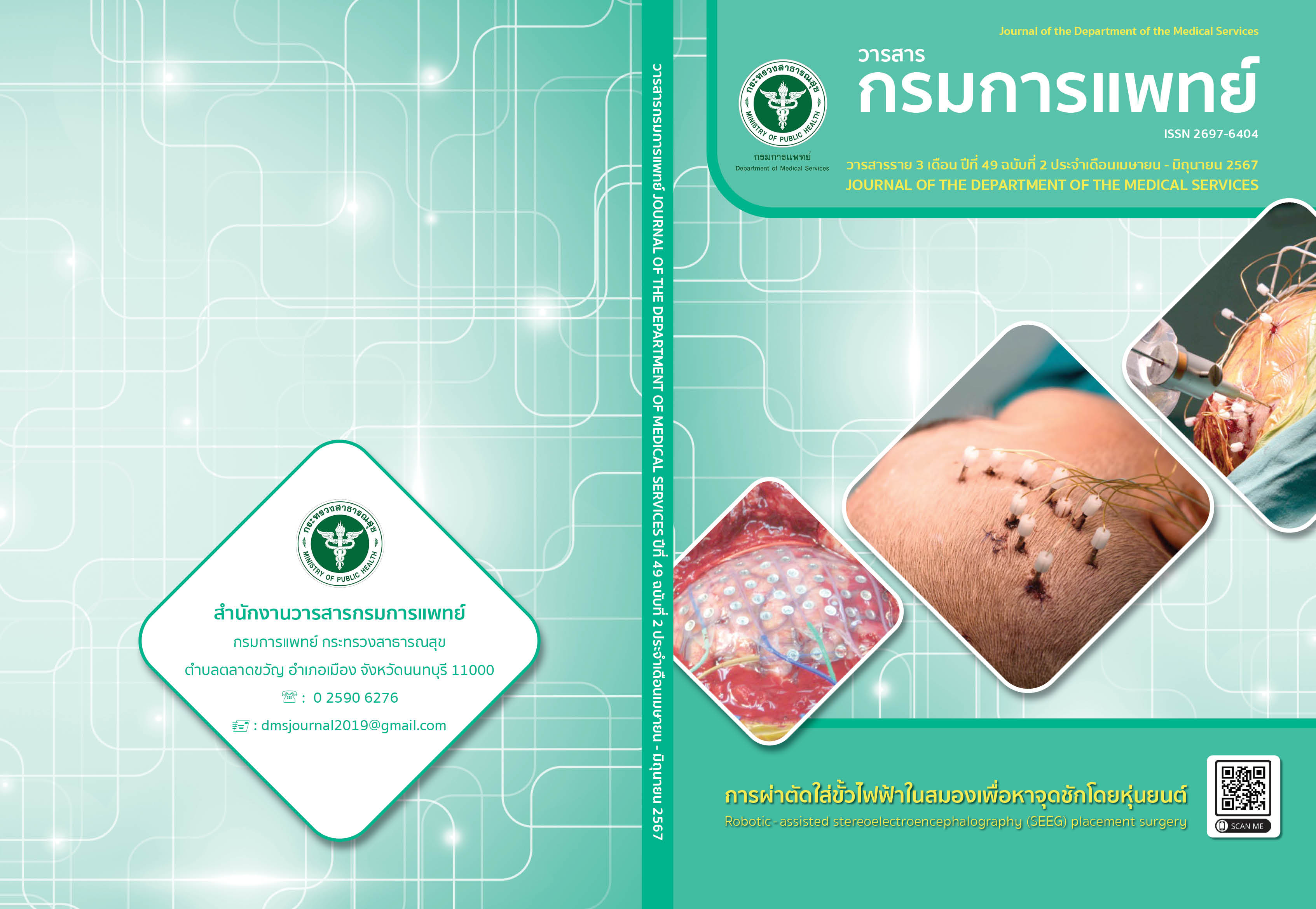Next-generation Sequencing Findings and Clinical Correlations in Children with Unknown Causes of Epilepsy at a Tertiary Care Pediatric Hospital in Thailand
Keywords:
Genetic, Epilepsy, Children, Next-generation sequencing (NGS)Abstract
Background: Next-generation sequencing (NGS) has become an increasingly important technique for identifying the unknown causes of pediatric epilepsy. NGS increased the diagnostic yield by at least 30-40% in children with epilepsy, but these data in Thai children is still limited. This study aimed to determine the diagnostic yield and factors associated with the detection of disease-causing genes by NGS in children with unknown causes of epilepsy in Thailand. Methods: A single-center retrospective study of 42 children with unknown causes of epilepsy who had available NGS results for the diagnosis of genetic epilepsy from Jan 1st, 2015 to June 30th, 2021, was conducted at Queen Sirikit National Institute of Child Health, Thailand. Patients with identified causes of epilepsy were excluded. Gene variants were classified based on their pathogenicity, and related clinical factors were determined. Results: Of the 42 unexplained causes of epilepsy with available results from their NGS tests, 50% had a disease-causing gene detected and were identified as genetically causing epilepsy. Among these 21 patients with NGS-identified genetic epilepsy, 57.1% were female, 33.3% had a family history of epilepsy, 4.8% had a history of consanguinity, and all of them were developmentally delayed. The most common identified disease-causing gene was SCN1A (38.1%). The factor significantly associated with the detection of disease-causing genes was Dravet phenotype (p-value = .004), and other clinical parameters were not significant factors. Furthermore, the change in patient management after available NGS results was significantly greater in patients with NGS-identified genetic epilepsy than in those without NGS-identified genetic epilepsy (61.9% vs. 4.8%, p < .001). Conclusions: Genetic testing should be advised for finding disease-causing genes in children with undiscovered causes of epilepsy since genetic abnormalities were discovered by NGS in 50% of children with unknown causes of epilepsy, and the clinical care for these patients may change.
References
GBD 2016 Epilepsy Collaborators. Global, regional, and national burden of epilepsy, 1990 - 2016: a systematic analysis for the Global Burden of Disease Study 2016. Lancet Neurol 2019;18(4):357-75.
Camfeld P, Camfeld C. Incidence, prevalence and aetiology of seizures and epilepsy in children. Epileptic Disord 2015;17(2):117-23.
Scheffer IE, Berkovic S, Capovilla G, Connolly MB, French J, Guilhoto L, et al. ILAE classification of the epilepsies: position paper of the ILAE commission for classification and terminology. Epilepsia 2017;58 (4):512-21.
Poduri A. When should genetic testing be performed in epilepsy patients? Epilepsy Curr 2017;17(1):16 - 22.
Rexach J, Lee H, Martinez - Agosto JA, Németh AH, Fogel BL. Clinical application of next - generation sequencing to the practice of neurology. Lancet Neurol 2019;18(5):492-503.
Wang Y, Du X, Bin R, Yu S, Xia Z, Zheng G, et al. Genetic variants identified from epilepsy of unknown etiology in Chinese children by targeted exome sequencing. Sci Rep 2017;7:40319.
Richards S, Aziz N, Bale S, Bick D, Das S, Gastier - Foster J, et al. Standards and guidelines for the interpretation of sequence variants: a joint consensus recommendation of the American College of Medical Genetics and Genomics and the Association for Molecular Pathology. Genet Med 2015;17(5):405-24.
Viravan S, Meesamarnpong C, Thongnoppakhun W, Chanvanichtrakool M. Genetic analysis of children with dravet syndrome in a resourcelimited setting. J Health Sci Med Res 2022;40(3):301 - 8.
Boonsimma P, Ittiwut C, Kamolvisit W, Ittiwut R, Chetruengchai W, Phokaew C, et al. Exome sequencing as frst - tier genetic testing in infantile - onset pharmacoresistant epilepsy: diagnostic yield and treatment impact. Eur J Hum Genet 2023;31(2):179 - 87.
Chokvithaya S, Caengprasath N, Buasong A, Jantasuwan S, Santawong K, Leela - adisorn N, et al. Nine patients with KCNQ2 - related neonatal seizures and functional studies of two missense variants. Sci Rep 2023;13(1):3328.
Boonsimma P, Suwannachote S, Phokaew C, Ittiwut C, Suphapeetiporn K, Shotelersuk V. A case of GABRA5 - related developmental and epileptic encephalopathy with response to a combination of antiepileptic drugs and a GABAering agent. Brain Dev 2020;42(7):546-50.
Ittiwut C, Poonmaksatit S, Boonsimma P, Desudchit T, Suphapeetiporn K, Ittiwut R, et al. Novel de novo mutation substantiates ATP6V0C as a gene causing epilepsy with intellectual disability. Brain Dev 2021;43(3):490-94.
Gasser M, Boonsimma P, Netbaramee W, Wechapinan T, Srichomthomg C, Ittiwut C, et al. ATP1A3 - related epilepsy: report of seven cases and literature - based analysis of treatment response. J Clin Neurosci 2020;72:31-8.
Chokvithaya S, Caengprasath N, Buasong A, Jantasuwan S, Santawong K, Leela - adisorn N, et al. Nine patients with KCNQ2 - related neonatal seizures and functional studies of two missense variants. Sci Rep 2023;13(1):3328.
Zou D, Wang L, Liao J, Xiao H, Duan J, Zhang T, et al. Genome sequencing of 320 Chinese children with epilepsy: a clinical and molecular study. Brain 2021;144(12):3623-34.
Symonds JD, McTague A. Epilepsy and developmental disorders: Next generation sequencing in the clinic. Eur J Paediatr Neurol2020;24:15-23.
Lee J, Lee C, Ki CS, Lee J. Determining the best candidates for next - generation sequencing - based gene panel for evaluation of early - onset epilepsy. Mol Genet Genomic Med 2020;8(9):e1376.
Rim JH, Kim SH, Hwang IS, Kwon SS, Kim J, Kim HW, et al. Efficient strategy for the molecular diagnosis of intractable early - onset epilepsy using targeted gene sequencing. BMC Med Genomics 2018;11(1):6.
Truty R, Patil N, Sankar R, Sullivan J, Millichap J, Carvill G, et al. Possible precision medicine implications from genetic testing using combined detection of sequence and intragenic copy number variants in a large cohort with childhood epilepsy. Epilepsia Open 2019;4(3):397-408.
Sheidley BR, Malinowski J, Bergner AL, Bier L, Gloss DS, Mu W, et al. Genetic testing for the epilepsies: A systematic review. Epilepsia 2022;63(2):375-87.
Downloads
Published
How to Cite
Issue
Section
License
Copyright (c) 2024 Department of Medical Services, Ministry of Public Health

This work is licensed under a Creative Commons Attribution-NonCommercial-NoDerivatives 4.0 International License.
บทความที่ได้รับการตีพิมพ์เป็นลิขสิทธิ์ของกรมการแพทย์ กระทรวงสาธารณสุข
ข้อความและข้อคิดเห็นต่างๆ เป็นของผู้เขียนบทความ ไม่ใช่ความเห็นของกองบรรณาธิการหรือของวารสารกรมการแพทย์



